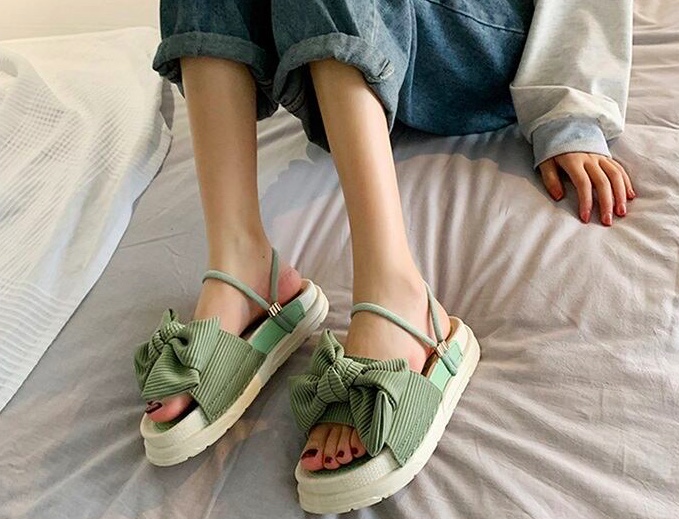The soreness caused by wearing sandals can be prevented by taking the right measures to prevent the cause. By choosing sandals that fits your size and making some adjustments to the areas where soreness occurs, you can free yourself from the worry of tenderness!
Sandals, which range from sporty to elegant designs, are an essential item for women’s fashion. When summer is just around the corner, shoe stores begin to display a variety of sandals, which can be very exciting.
One thing to worry about when wearing sandals, however, is that you might get sore feet on your favorite sandals. If you get sores, it’ll be painful and you will not be able to walk properly. It would be sad if the pain halved the enjoyment of your outing.
Shoe sore is caused by friction between the skin and the sandals. The cause of sandal soreness is the friction between the sandal and your skin every time you walk. This is because sandals are more intricately designed than pumps or sneakers which are often worn barefoot. The seams, cuts, and straps of sandals are particularly prone to friction. When the skin becomes red and sore, it is a sign that shoe rubbing has begun. If you continue to wear them as they are, they will tingle and eventually get worse. In addition, during summer, sweaty feet cause the skin to flatten, which tends to lead to unwanted chafing. Sandals can cause blisters, calluses, and other shoe abrasions in the same places year after year, which can lead to hardening and pigmentation of the skin. For women who want to keep their feet beautiful, this is a dilemma.
In addition, if women continue to walk while enduring the pain caused by shoe rubbing, their posture will deteriorate, causing stress on the hips and knees, as well as concerns about big toe problems.
Let’s try to prevent friction between sandals and feet, and aim for worry-free feet!
Causes of sandal rubbing
The major causes of sandal rubbing against the skin are the size of the sandal and the construction of the sandal. If you put priority on appearance only because they are fashionable or cute, you may end up injuring your own feet.
The sandal size is not right
Are the sandal sizes you have chosen really suitable for your feet? If you easily choose the same size as the pumps you usually wear, you may create shoe sores. Sandals are often designed with open heels and toes, so even if the size is slightly wrong, you can wear them anyway. Some sandals are available in 0.5 cm increments, while others are roughly classified as S, M, or L, making it difficult to find the right size.
Stiff straps
If the straps of sandals are hard, the sandals will hit the feet hard and cause shoe sores easily. This is because the material is not supple enough to fit nicely along the shape of the foot. Even if you don’t feel anything at the beginning of wearing the sandals, if you spend a lot of time walking around or your feet begin to swell in the evening, the hard straps tend to rub against your skin and hurt your feet.
Sandals are not the right shape
Everyone has a different foot shape. Some have a high instep, some have a low instep, some have wide or narrow feet. The length of the toes also varies from person to person.
The shape of sandals also varies. If you choose sandals without considering the width of your feet or the height of your instep, the narrow band or the part of the sandal that touches the instep will dig into your feet and cause soreness.
The perforations will hit your skin
Sandals with a design that combines a number of thin belts will have many perforated seams. Some sandals are intentionally designed to look fashionable by adding stitches with threads of a different color from the material. Depending on the material of the sandals, the stitches may be raised above the material surface and may come in direct contact with the skin. If this happens, the threads against the skin rub against the sandals every time the wearer walks, causing soreness.
How to choose sandals that are less likely to cause shoe sores
When buying new sandals, there are several points to keep in mind so that you can choose sandals that are less likely to cause soreness. If you keep these points in mind, you don’t have to give up on the idea that soreness is inevitable with sandals.
Do not overhang the toes
For sandals with an open toe, choose a sandal with a toe that does not stick out too far. A good rule of thumb is to allow about 5mm of room. Most sandals are designed to expose the toe. If the toes stick out more than the sandal, the foot will slide forward and rub against the skin. If your fingers stick out, they may rub against the ground when you walk, which can cause injury.
Toes are not too narrow
Sandals with extremely narrow toes are designed to squeeze the fingers tightly, making them prone to soreness. If you force yourself to wear them, the surfaces of your fingers, or thumbs and little toes, which tend to be exposed to the material, are more prone to soreness. Be especially careful if you have five toes that are all about the same length, if your thumb is the longest of the five toes, or if you are concerned about your big toe.
You need something that doesn’t dig into your feet
It is also important to make sure that the instep and straps do not dig into your skin when you try on the sandals. If the instep is too tight or the straps dig into your feet and stick out, it is not a good idea. On the other hand, if the sandals are too tight for your feet, they will rub all over the place because your feet will not be in the right position in the sandals. Choose sandals that fit well.
Adjustable belt length
When wearing sandals with a back belt (back strap) or ankle strap (ankle strap), an adjustable belt will reduce the risk of shoe chafing. If the length of the belt can be adjusted to exactly the right length, it will increase stability and make walking much easier.
The belt can be adjusted with adjustable holes or Velcro. The Velcro type is recommended for casual or sporty occasions, while the adjustable hole type is recommended for dates or important outings.
How to prevent shoe sores on sandals
Shoe sores, which can be a disheartening experience, can be reduced with a little effort. To feel comfortable in your sandals without pain, try the following tips before you put them on.
You may even combine a few of these methods!
Wear sandals that fit you
Always wear sandals that fit your feet. Be patient and don’t buy them at first sight. Always try them on at the shoe store. If you are not sure, talk to the store staff and ask for their advice.
Be especially careful when shopping online. You can prevent mistakes by referring to reviews and choosing a site that allows you to exchange sizes in case of emergency.
Apply Vaseline
It is also effective to apply Vaseline to areas where the sandals rub against your skin every time you walk. Vaseline smoothes out friction and avoids shoe chafing, which can cause the skin to peel.
Unilever’s Vaseline is a safe care product used in over 90 countries worldwide. It is fragrance-free and color-free and can be applied directly to sandals. You can also apply Vaseline to your skin for its excellent protective and moisturizing properties. If Vaseline is not available and the situation is urgent, try baby powder or solid soap instead.
Fit the soles of your feet tightly with pads
If your feet still pucker when you wear sandals, insole cushions can help your feet fit snugly inside the sandals and prevent chafing. This is especially useful for sandals with high heels, as it helps prevent the forward slipping that is common in sandals.
If you choose transparent pads, they will not be noticeable on the sandal. Gel pads also relieve foot pain caused by excessive walking, so you can kill two birds with one stone.




Comments